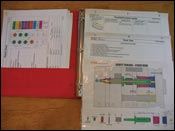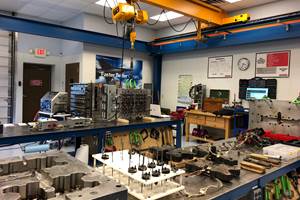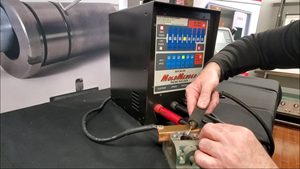Maintenance Manuals That Work
Organized maintenance manuals can offer an advantage that electronic data does not.
OK—I admit it—I’m a manual freak, probably because I hate going the wrong way or redoing a task if there is a deadline involved. Being under the gun to hurry and figure out how something works inside a mold or how it comes apart mutes the pure joy of the challenge of doing so. The mistakes made and wasted time involved to do something wrong or out of sequence can have potentially disastrous results on expensive components. But with a good manual in hand, everything makes sense, and quickly.
Why a Manual?
In this age of electronic data, manuals might seem like an inefficient idea. But organized maintenance manuals can offer an advantage that electronic data does not. First, diversity. For electronic information to work, connectivity between departmental and company systems must be present, or the data is not readily accessible. Supervisors and managers must either share folders on a server or rely on each other to send Excel type or other data via e-mail in a timely manner.
Manuals allow the user to document, store and utilize a variety of information from different sources quicker than most can pull it up on their screens. And for molds moving from plant to plant, maintenance manuals can easily travel with the mold. Many of the issues I see today are the result of molds moving about, with no history. This means at each stop, mold characteristics must be relearned by repair technicians.
Second, old school skill. Many toolmakers today are baby-boomers not “PC trained” who feel much more comfortable analyzing data with something they can hold in their hands rather than fumbling through different computer screens.
For many, when troubleshooting for a defect trend or pattern, laying out past cavity positions (mold maps) by run/repair sequence on a table is a faster, more accurate method than seeing these condensed on a small monitor. Craftsmen are spatial people who sometimes need to grab something, hold it or see it in real scale to better troubleshoot mechanical issues.
Files, Logbooks or Manuals
There is a difference. Mold files typically contain a bunch of old greasy work orders of completed repairs. The W/O’s never stay in sequence and get ripped out of a binder and are a pain to sort. Other things like Excel spread sheets, cavity layouts, tooling inventory lists, notes on napkins and scrap pieces of paper all make their way into a mold file.
Log books are nothing more than manual entries of everything that happens to a mold (but are better at sequential data) during the run/repair cycle. Log books don’t hold other data that is needed. With both methods you never know what you are going to get.
Manuals differ as they contain all of the above information and much more in specific sections. What separates a useful manual from one that is not are the type, amount, accuracy (current, legible, correct), overall size and accessibility of the information. A properly formatted manual is a great tool to use that few toolmakers can do without once it becomes part of your daily troubleshooting and maintenance process.
Building a Manual
A manual is a collection of live, working documents, whose information can change at any time—such as in a discovery of a quicker, more accurate technique to perform a specific task during the repair or the root cause of an issue that you have been struggling with. As more is learned about a mold, this information is constantly updated or edited. Building a manual means creating sections, or tabs to keep certain information separated. Then as the mold runs, performance and repair data can be added, removed or changed quickly and easily without disrupting the order of the manual. Mold manual layout, or sections can be generic among your molds for the most part, so navigating through the tabs for specific information can be learned quickly by repair technicians.
Manual Size
Most manuals in use today usually come pre-populated from the mold builder. Many have a full set of prints, maintenance tips and hot runner specs. Problem is these manuals need to be 3 to 4 inches thick to contain the prints and other information that is not typically needed every repair. The shear size makes it a bear to use and store on a daily basis. For this reason, prints should be stored in a separate filing cabinet, and only current run/repair data kept in the manual.
It is quite easy to store all the info you will ever need in a 1 or 1-1/2 inch 3-ring binder. A 1 to 1-1/2 inch will handle most molds. A 2-inch may be required if the mold has a hot runner system and came with a large service manual that you want to keep in the main mold binder. The idea is to have handy in the main manual only what is needed during typical repairs, and not everything about the design or build of a mold. You can go get that info when required. Keeping the manual current will keep it smaller.
Manual Contents
Maintenance manuals should contain these aspects of mold history and in specific sections:
- One year’s worth, or at least 12 past PM Work Orders or Repair Sheets. These should be numbered prominently and sequenced by the run/repair cycle at the top corner of the page and kept in the sleeve of the front cover.
- A “cover” sheet showing an image of the part/parts that a mold produces including product changes.
- Tooling configuration list for above product changes.
- A Troubleshooting Guide that contains specific defect terminology, images, probable causes and corrective and preventative actions.
- A Tech Tips section that explains specific, critical sequences, practices, procedures or special tools required for disassembly, cleaning, polishing and assembly.
- A Final Check procedure.
- Digital images of mold plates and components in various stages of repair are also extremely helpful.
- In the sleeve of the back cover is a good place for critical run/repair related e-mail or miscellaneous handwritten correspondence from other shops that have run this mold.
Using Manuals
To keep manuals current and accurate, it is necessary to periodically edit and update the information within. It should be noted in every company’s SOP (Standard Operating Practices) that the manual is part of the required maintenance documentation to be reviewed by either the toolroom supervisor, lead man or the repair technician every time a mold hits the bench, and not just when it is fat with old data.
A good spot to store mold manuals is right next to the toolroom supervisor and within easy reach when on the phone. In a busy shop, the supervisor fields many calls/conversations concerning mold performance or repair and assigns tasks. Storing work orders in a manual that is located in the office provides the repair tech and supervisor a chance for a quick overview of planned repairs when handing the manual off. Repair technicians help by also keeping an eye open for inaccuracies in manual data and inform the supervisor when changes or updates need to be made. This way terminology stays consistent and accurate. And for supervisors, the act of editing manuals keeps you current and informed since you are not witness to every repair, cleaning or tooling change made.
Double Your Pleasure
Maintenance manuals effectively bridge the gap between completely paperless systems and those totally manual, and allow the best features of the two to combine for faster, more accurate and safer repairs. This will greatly enhance troubleshooting efforts by providing a valuable tool for data analysis that most craftsmen are comfortable with, and will want to use every day.
Related Content
What You Need to Know About Hot Runner Systems and How to Optimize Their Performance
How to make the most out of the hot runner design, function and performance.
Read MorePortable Low-Heat, Non-Arcing Resistance Welder for Mold Repair
Rocklin’s user-friendly MoldMender Micro Welder delivers simple and cost-effective localized repair in-house with precision and versatility, enhancing mold and die durability and reducing disassembly and downtime.
Read MoreWhat is Scientific Maintenance? Part 2
Part two of this three-part series explains specific data that toolrooms must collect, analyze and use to truly advance to a scientific maintenance culture where you can measure real data and drive decisions.
Read MoreLaser Welding Versus Micro Welding
The latest battle in finely detailed restoration/repair of mold materials.
Read MoreRead Next
Build-Ups for Maintenance: Benefit or Band-Aid?
When is providing build-ups on tooling appropriate and when is it just a band-aid on a problem that could lead to more extensive repairs later?
Read MoreReasons to Use Fiber Lasers for Mold Cleaning
Fiber lasers offer a simplicity, speed, control and portability, minimizing mold cleaning risks.
Read MoreAre You a Moldmaker Considering 3D Printing? Consider the 3D Printing Workshop at NPE2024
Presentations will cover 3D printing for mold tooling, material innovation, product development, bridge production and full-scale, high-volume additive manufacturing.
Read More





















